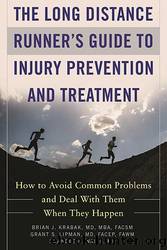The Long Distance Runner's Guide to Injury Prevention and Treatment by Brian J. Krabak

Author:Brian J. Krabak
Language: eng
Format: epub
Publisher: Skyhorse
Published: 2017-01-15T00:00:00+00:00
Chest Pain
A differential diagnosis of chest pain in athletes is presented in Table 15-1. Cardiac causes of chest pain are relatively uncommon in athletes under thirty-five years old. While infrequent, cardiac causes include potentially life-threatening diseases such as coronary artery anomalies and hypertrophic cardiomyopathy. In contrast, older athletes with exertional chest discomfort are presumed to have atherosclerotic coronary artery disease until proven otherwise. Cardiac chest pain seen in athletes may be a result of coronary artery disorders, valvular heart disease, diseases of the heart muscle, disorders of the aorta, and electrophysiologic disorders.
Cardiac chest pain in runners generally presents as chest discomfort that reproducibly develops with exertion, resolves with rest, and is located in the substernal and/or left chest area. The discomfort is characterized as an ache, pressure, or tightness that can radiate to the jaw or arm, and can be accompanied with a sense of air hunger. Some athletes may experience chest discomfort during the initial few minutes of exercise that abates with continued exertion. This is commonly referred to as âwarm-up angina,â a process that reflects focal early exercise coronary artery blood flow insufficiency that is relieved by the subsequent recruitment of collateral arteries. It should not be ignored and should prompt comprehensive assessment for underlying atherosclerotic coronary artery disease. More subtle symptoms such as an unexplained decrease in exercise tolerance or inability to maintain prior race paces should be considered abnormal and medical evaluation should be sought.
In general, symptoms related to a blood flow imbalance in the heart, suggestive of congenital or acquired coronary artery disease, will resolve within several minutes of rest or reduced activity. Common alternative patterns of chest symptoms associated with non-coronary forms of cardiac disease and non-cardiac diagnoses deserved mention. Sudden, sharp tearing chest pain that radiates to the back and is precipitated by intense isometric exercise or body collision may be manifestations of an aortic dissection, a potential life threatening condition that requires immediate medical attention. Chest pain following a systemic viral illness that is positional in nature, intensifies while lying supine and is not usually intensified by exercise, suggests pericarditis, an inflammation of the lining of the heart. The diagnosis of pericarditis often comes in conjunction with myocarditis, inflammation of the heart muscle with attendant risk of arrhythmia, and accordingly should be not be missed. Chest discomfort, often associated with mild to moderate air hunger, that is provoked by exercise in conjunction with climate extremes or seasonal allergens is often indicative of reactive airway disease (bronchospasm) and not primarily cardiac in nature. Chest discomfort that occurs immediately after a large meal may suggest a gastrointestinal cause. Non-cardiac causes of chest pain including symptoms of reactive airway disease or gastroesophageal reflux disease can last for minutes to hours.
Table 15-1 Common non-cardiac causes of chest pain.
System/Condition
Symptoms
Risk Factors
Download
This site does not store any files on its server. We only index and link to content provided by other sites. Please contact the content providers to delete copyright contents if any and email us, we'll remove relevant links or contents immediately.
| Cricket | Field Hockey |
| Lacrosse | Rugby |
| Track & Field | Volleyball |
Going Long by Editors of Runner's World(2298)
The Happy Runner by David Roche(2194)
Yoga For Dummies by Georg Feuerstein(1420)
Becoming Boston Strong by Amy Noelle Roe(1348)
Legacy by Kerr James(1272)
Winger by Smith Andrew(1225)
The Little Red Book of Running by Scott Douglas(1172)
Wodehouse At the Wicket by P.G. Wodehouse(1096)
Bowerman and the Men of Oregon by Kenny Moore(1093)
The Way of the Runner by Adharanand Finn(1073)
5050 by Dean Karnazes(1063)
Running Your First Marathon by Andrew Kastor(1042)
Swim, Bike, Run - Eat by Tom Holland(1025)
The Coming Storm by Nigel McCrery(989)
Blade Runner by Oscar Pistorius(988)
Spiked (Blocked Book 3) by Jennifer Lane(981)
The Grade Cricketer by Dave Edwards(952)
The Shared Origins of Football, Rugby, and Soccer by Christopher Rowley(950)
The Amazing Test Match Crime by Adrian Alington(944)
